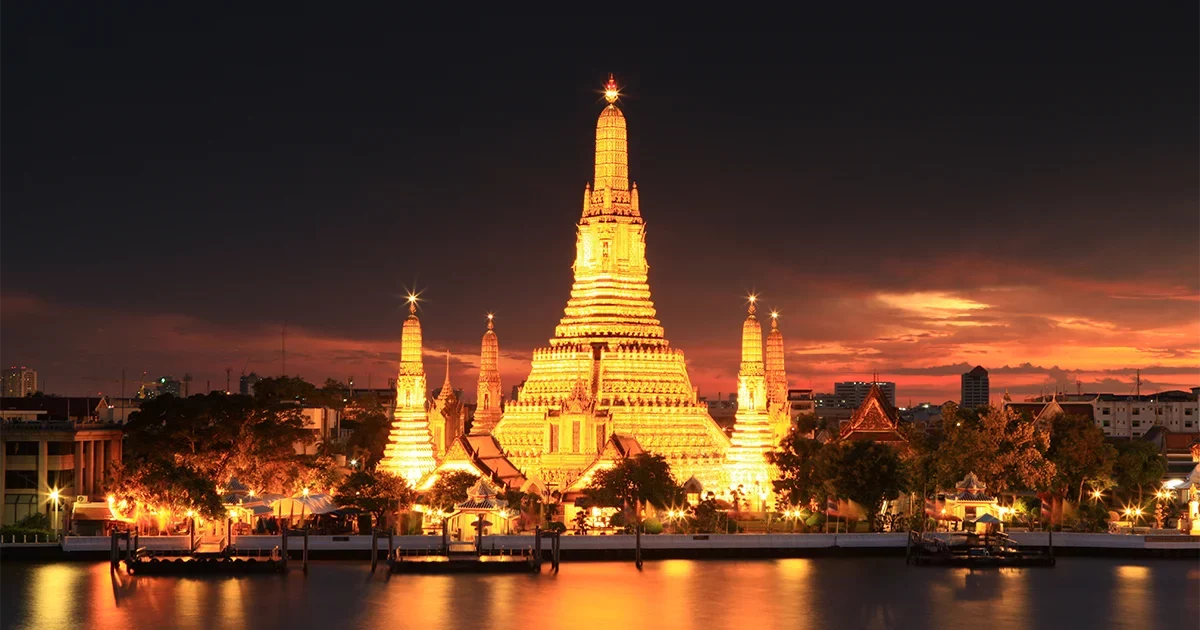
Wat Arun Ratchawararam, also known as “Wat Chaeng” or the Temple of Dawn, is one of Bangkok’s most iconic landmarks. Nestled along the west bank of the Chao Phraya River, directly across from Wat Pho, this ancient temple has a rich history that dates back to the Ayutthaya period. Originally known as “Wat Makok Nok,” it was later renamed by King Taksin the Great, who arrived at the temple at dawn after establishing Thonburi as the new capital of Siam. He named it “Wat Chaeng,” meaning “Temple of Dawn.” However, during the reign of King Rama II, the temple underwent extensive renovations and was renamed “Wat Arun Ratchatharam.” In the reign of King Rama IV, the name was changed again to “Wat Arun Ratchawararam,” and the ashes of King Rama II were enshrined within the principal Buddha image in the Ubosot.
The Ubosot (Ordination Hall): Constructed during the reign of King Rama II, the Ubosot is an elevated structure with a two-tiered roof covered in yellow tiles, bordered by green leaf-patterned tiles. The chofa (ornamental finials), bai raka (decorative ridges), and hang hong (swan-like motifs) are gilded and adorned with glass mosaics. Both the front and rear pediments feature intricate wood carvings depicting celestial beings holding swords, surrounded by conch shells and water jugs placed on pedestals. These carvings are embellished with gold lacquer and glass inlays.
Inside the Ubosot, visitors can admire exquisite murals that depict scenes from the life of the Buddha, including his victory over Mara and the Vessantara Jataka. The principal Buddha image, named “Phra Buddha Dhammisirirat Chodilok,” is seated in the Maravijaya posture (subduing Mara). Beneath its pedestal lies the relics of King Rama II. Surrounding the Ubosot is a beautifully designed corridor instead of a traditional boundary wall, featuring floral patterns and peacocks painted on the walls. Along the corridor, 144 granite statues of Chinese soldiers stand guard, while four octagonal stupas at each corner house additional granite figurines, referred to as the Eight Immortals.
The Prang (Main Tower): The towering prang of Wat Arun is perhaps its most recognizable feature. Standing at over 80 meters tall, the central prang represents Mount Meru, the center of the universe in Buddhist cosmology. It is adorned with colorful porcelain and seashells arranged in intricate floral designs. Smaller prangs, called Prang Tis , are located at the four cardinal directions around the main tower. Each Prang Tis features niches containing figures of mythical creatures like kinnaras (half-human, half-bird beings) and garudas (mythical birds). Above these niches, you’ll find depictions of gods riding horses, culminating in a spire crowned with naga-serpents and devas (deities).
Mondop (Pavilions): Four mondops are positioned between the Prang Tis on the second level of the base. These pavilions house different representations of the Buddha’s life stages: birth, enlightenment, first sermon, and passing into Nirvana. The mondops themselves are constructed similarly to the prangs, decorated with porcelain and glass mosaics.
The Wihan (Assembly Hall): The Wihan is another architectural masterpiece, characterized by its three-tiered roof covered in glazed tiles. The gable ends display celestial figures holding swords, set against a backdrop of golden floral motifs and glass inlays. Inside, the hall houses several important Buddha images, including “Phra Buddha Champa Nu Thamahaburut Lakkanayuphat,” alongside other revered statues.
Smaller Structures:
Chinese Pavilion and Artificial Mountain: Six Chinese-style pavilions line the riverfront area, providing shaded rest areas for visitors. Behind them stands an artificial mountain brought from the Grand Palace during the reign of King Rama III. This mountain is enclosed by a fence and features two stone lions guarding the entrance.
Monument of Phra Dhamma Chedi: South of the artificial mountain lies the monument dedicated to Phra Dhamma Chedi, a former abbot of the temple. Enclosed by a low wall, the monument includes a sandstone urn containing his ashes, miniature mountains, and a Chinese-style pagoda housing stone figurines representing prosperity, longevity, and happiness.
Wat Arun is not only a place of worship but also a cultural and historical treasure trove. Its stunning architecture reflects a blend of Thai, Khmer, and Chinese influences, making it a must-visit destination for tourists. Visitors often rent traditional Thai costumes to take memorable photos against the backdrop of the majestic prang, capturing the essence of Thailand’s rich heritage.
In conclusion, Wat Arun Ratchawararam offers a unique glimpse into Thailand’s past through its magnificent structures and artistic details. Whether you’re interested in history, architecture, or simply seeking a serene environment, this temple promises an unforgettable experience.
License TAT: 51/01110
We offer a wide range of travel packages designed to suit every interest and budget. Discover the world with us through these exciting categories:
เมนูที่เกี่ยวข้อง
เกี่ยวกับเรา
รอบรู้เรื่องเที่ยว
ลูกค้าของเรา
ข่าวสารท่องเที่ยว
วีดีโอท่องเที่ยว
คำรับรองจากลูกค้า
คำถามที่พบบ่อย
ติดต่อเรา
นโยบาย เงื่อนไขและข้อตกลง
นโยบายคุกกี้
นโยบายความเป็นส่วนตัว
เงื่อนไขสินค้าและบริการ
เงื่อนไขการชำระเงิน/คืนเงิน